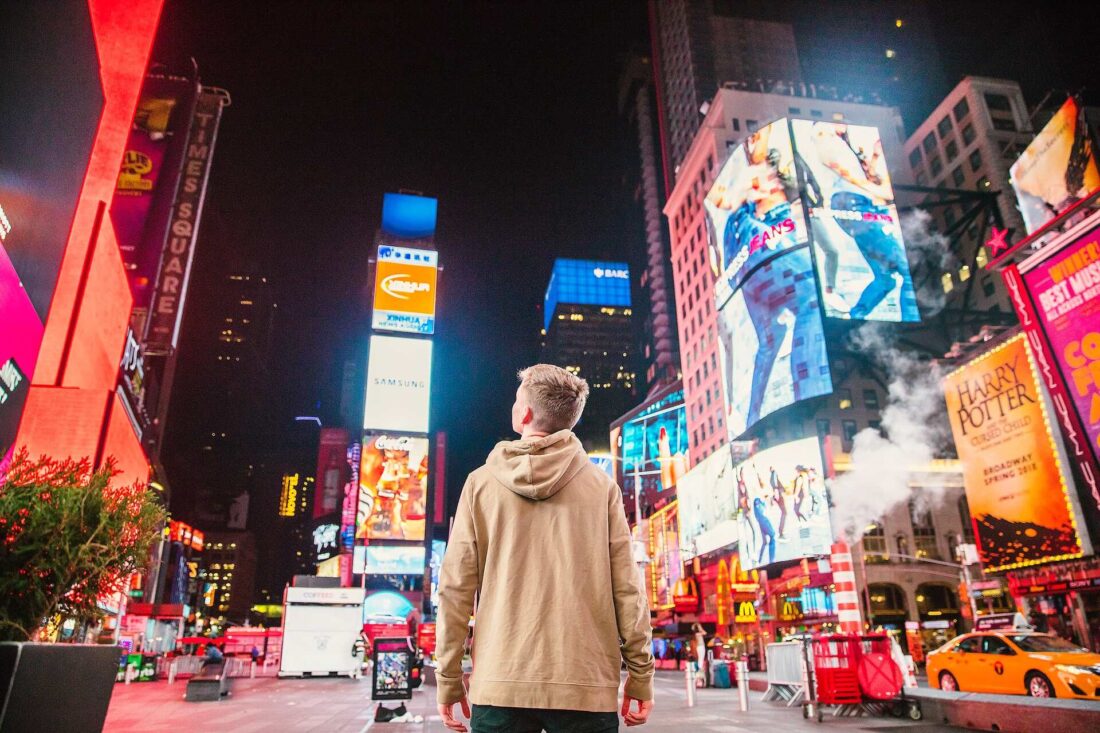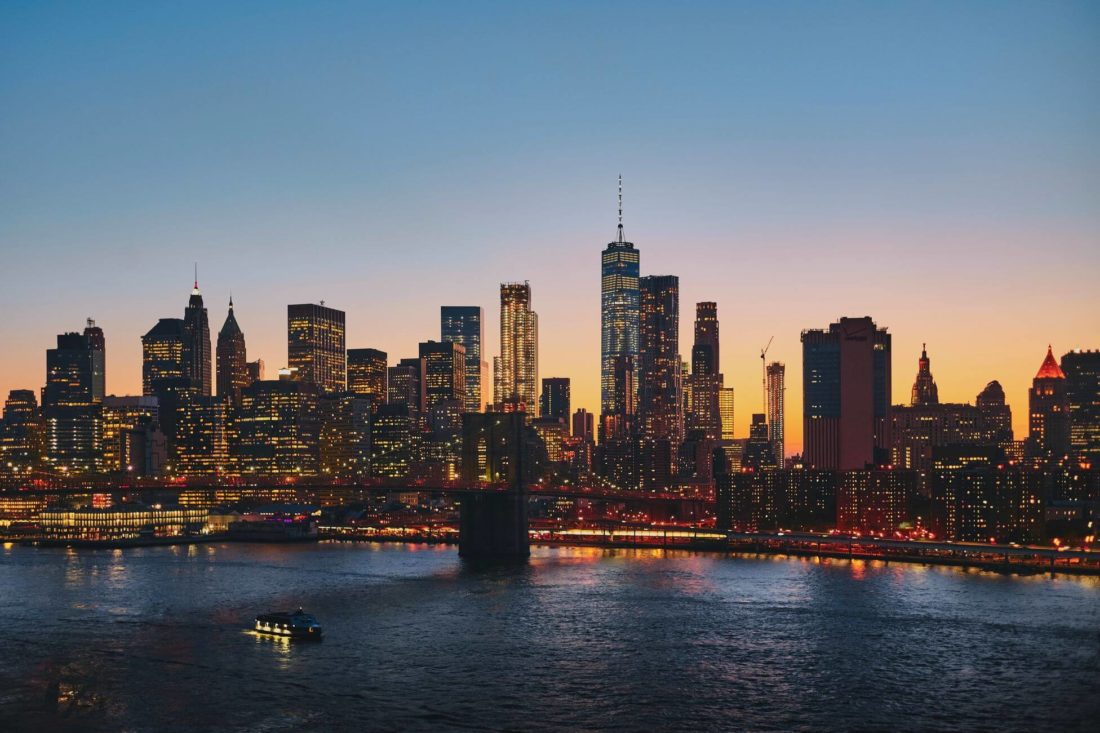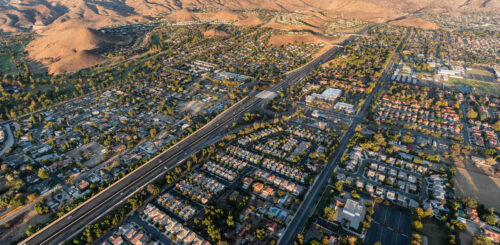A city of diversity and disparity, hovering from extreme wealth and power to homelessness, from utmost popularity to total anonymity, from high hopes to broken dreams – the Big Apple has it all. That’s why moving to New York City and becoming a citizen of the unofficial Capital of the World is an adventure unlike anything else in your life.


Even though it is not large in area, it has around 8.6 million inhabitants, and living here is not always easy, but it is always exciting. So, if you encounter impatience among New Yorkers, give them a break. Underneath that rigid attitude, there is a kindness you just need to discover. An interesting fact is that almost half of the population are people born outside the US, which is just another proof of the Big Apple’s global appeal and its profoundly international character.
The competition here is extreme, and “if I can make it there, I’ll make it anywhere,” as the famous song says, is true regardless of whether you’re in the field of media, finance, tech, or any other industry. The fierce competition has led many businesses to work around the clock, so buying whatever you need in the wee hours is no problem.
The culture is vibrant, whether you want to see a Broadway show or go to a music concert in Madison Square Garden, or visit museums like the Metropolitan and MoMa or any other cultural venue. Regarding outdoor activities, apart from its famous parks, like Central Park, this town has beaches reachable by public transport, like Coney Island or Rockaway Beach.
Should I Move to New York? Life in NYC Has Its Price
Being considered the “center of the world,” it is no wonder people search for how to move to New York, with costs of living 22% higher than the national average. There are more and less affordable areas to live in like anywhere else, but generally, the cost of living in New York is considered high compared to other cities. So, unless money is not the issue, you will probably have to give up some luxuries or comforts to be able to call the City That Never Sleeps your home.
Before relocating, whether by yourself or with the help of New York movers with professional long-distance moving services, make a moving-out budget and plan your finances for the first period carefully. Consider finding a job in your new city so you won’t have to worry about finances.
How Much Does Living in NYC Cost?
After economic instability caused by the recession, the city is recovering fast. GDP is higher than in other major US towns, personal income is rising and the unemployment rate is nearly 4%. However, the gap between the richest and poorest residents is growing. Almost half of the households are rented, costing the inhabitants more than 30% of their annual income just to rent, not to mention other bills. That is why having roommates is a common way of living here.
Highest Taxes in the US
Income taxes are paid on the federal, state, and city levels. Tax rates can go very high, depending on income. The property tax is paid based on the living area and property size. If you are buying an apartment, you will be subject to real estate transfer tax. The sales tax added to goods and services is relatively high, amounting to 8.875%, so prices are usually displayed without it.
Housing and Rental Costs
For the majority of people here, homeownership is not easily achieved because of the high home values. The median price for a home is $668,500, and the median rent price is $2,899. If browsing through the boroughs, Manhattan is obviously the most expensive, with a median home value of $1,322,100, followed by Brooklyn with $718,400 and Queens with $517,800.


Getting an Apartment in New York
Choosing an apartment depends on what your priority is, whether it is the location, the size, or the price. If it is the location, you will have to give up some comfort regarding the size of the place. If it is still out of your budget limits, you might opt for some neighborhoods not very far from downtown, but close to speedy trains that will get you anywhere in no time. If your priority is the space, you will have to search for an apartment outside the downtown area, unless you are quite well-off. You might be lucky to find a decent place in the Upper East or West Side for a reasonable price.
But if your moving-out budget is limited, you have to forget being in Manhattan since one of the requirements the landlords may pose before you is to have an income 40 times the home rent or otherwise find a guarantor. Again, if you get lucky, you might find a less expensive place in Washington Heights (Manhattan), Astoria (Queens), or Bushwick (Brooklyn). So, try to find a place that costs no more than a third of your annual income to be able to afford it.
Before renting, visit the best places to live in New York to check whether they are as described and meet the landlord or do some background search on him. You can even ask other tenants some basics about the building, such as maintenance. Remember you will have to pay a steep broker’s fee worth 10%-15 of your annual rent unless you manage to find a place without the broker’s services.
If getting a roommate is an option, which is very common in this metropolis, there are websites connecting interested persons you can check out. Apartments here are rather small, so before moving in, you will have to eliminate all surplus things you have accumulated.


Choosing the Best Neighbourhood in One of the 5 Boroughs
Although it is not large in area, this city is huge in population. It is divided into five administrative divisions called boroughs: Manhattan, Brooklyn, Queens, Bronx, and Staten Island. Each borough is divided into many neighborhoods. Before you find the one that best suits your needs, think about your priorities and visit places to get a sense of the area. Making a guide with all the facts, advantages, and disadvantages of each place will help you pick your top choices. Know that Manhattan is the most expensive, Queens is the largest by space, and Brooklyn by population.
Knowing the background of the neighborhood is also important if you want to become a real New Yorker, as many historical areas here have undergone gentrification. This town is diverse in so many aspects, so completely different neighborhoods should not surprise you. For example, flavors, colors, and images from Staten Island Little Sri Lanka are totally different from the smart Tudor houses in Forest Hills.
So, walk around to see how the neighborhoods breathe, how far is the subway, the quality, and selection of supermarket items, what the schools look like, how it feels at night, parking options, and other characteristics you deem necessary, and then start the search. There are also online options to check commute times, noise complaints, planned constructions, safety, and so on.


Getting Around the Big Apple
Walking in this town is inevitable. Whether from your place to a subway stop, to the store, or anywhere else you have to go – you will be walking quite a bit. You may find that walking a few miles is more convenient than changing different transportation means. However, apart from the subway system operating 24/7, there is also a bus network connecting all 5 boroughs of New York, ferry services, commuter rail lines, and bike-sharing programs. All in all, there are plenty of transportation options for you to choose from.
If you are planning to use auto transport services to bring your four-wheeler here, know that driving a car can be challenging. With the traffic jams, walking may be faster than going by car or cab. Plus, getting a parking space is difficult and costly. But if you insist on it, then you should know that you need to update your American driving license address or change your foreign driving license after 12 months for an American one if you are a tourist. If you are planning to work or study, you have to change it after 30 days.
The street layout is divided into avenues, running north and south, and streets, running east and west. Most of the streets are one-way. Manhattan, specifically, is organized in the form of a giant grid.


You’ll Need to Know the Subway Map
The subway system can seem complicated to a newcomer, so it is advisable to download the system map to a cell phone or get a paper map for your bag. It is rather efficient, running 24/7, connecting all parts of the town, but it is also facing some issues due to outdated technology and lack of investment, so you may encounter crowds and delays. The system consists of 25 lines and 472 stations, so knowing the map and studying it might help you get around easier.
Transportation Fares
Subway and buses are the most popular means of transportation in the Big Apple. Subway is mostly used for longer commutes and buses for shorter distances. The tickets for a single ride cost $2.75, the daily ticket costs $5.50, and the weekly pass for unlimited rides costs $32. The monthly season ticket for unlimited rides costs $116.50.
Drivers Can be Very Aggressive, So Ask Yourself “Should I Move to New York?”
Drivers here are fast and loud, and there are always traffic jams you need to deal with it. They neglect the speed limit, stop signs, or basic driving rules. The right of way is not always obeyed. And they honk a lot, so this is something to get used to.
Increase Your Walking Mileage
People walk the sidewalks in this town very fast, so you might have some trouble if you are slow. If you are strolling, do it in parks. Distances here can be deceiving, so you definitely need a solid pair of walking shoes. Wherever you go, whether to the bus stop, a park, or a store, it will take longer than you thought it would, or at least that is what it seemed on the map. There are about 20 streets in a mile and avenues are around 750 feet apart, so four avenues’ distance is more than half a mile.


Bring an Umbrella When Moving to NYC
It can rain a lot in NYC, and when it rains, it pours. So, an umbrella is a must if you want to remain dry. During the winter season, there can be some heavy snowstorms that have been known to paralyze the town.
Enjoy the Food and Restaurants
In a highly populated town, there must be many dining options to satisfy everyone’s taste. When it comes to the best restaurants in New York, you can find everything from fine, expensive restaurants to excellent street food. Plus, there are hardly any food ingredients you will not be able to find in the shop here.
A meal in an inexpensive restaurant will cost you from $12-$25, and takeout coffees range from $3.00-$5.00. Furthermore, bars are legally allowed to work from 7 a.m. until 4 a.m. in a City That Never Sleeps, so you can even grab a late-night dinner.


Landing a Job in One of the International Corporations
Moving for a job is the most common option in the Big Apple, and if you do not have one waiting for you, try to inquire in advance whether your profession is in demand. Being a communication and advertising hub, this metropolis logically offers a lot of job opportunities in this field.
Wall Street, the nation’s financial center is also a huge job market. However, the competition is tough. As everywhere, hospitality and service industries are always employing, you should not have trouble starting a career in this field. If you prefer to have some kind of job before you arrive, browse through the appropriate sites.
Since the living costs are high, so are the salaries. If you check the housing mentioned above and living costs, you can know what your salary should be to enable you to live a normal life. Perhaps you prefer freelancing? Numerous opportunities there, too. Just bear in mind that life in NYC is expensive.


A Place for International Companies
Although this is the city of small businesses if judging by the statistics, the fact remains that many large companies have their headquarters here. Among the companies are:
- American Express Company (financial services corporation)
- Bloomberg L.C. (financial, software, data, and media company)
- Citigroup Inc
- Goldman Sachs Group Inc
- JPMorgan Chase & Co
- Morgan Stanley (investment banks)
- Nasdaq, Inc. (financial services corporation)
- News Corporation (mass media corporation)
- Pfizer Inc (pharmaceutical corporation)
- Tiffany & Co (luxury jewelry and specialty retail)
- Zeta Global (customer lifecycle management marketing company)
Moving to New York City with Your Family
Even though this is not a quiet and peaceful town, which you can tell the minute you step out of your apartment, it is still an excellent place to live with your family. There are many parks and green spaces even downtown, along with fantastic museums, theaters, libraries, art galleries, ice skating ranges, and alike. And there are a lot of NYC public schools your kids can attend and learn everything they need. The best family-friendly areas are Forest Hills in Queens, Brooklyn Heights in Brooklyn, Staten Island, or Upper East and West Sides if you can afford it.


Best Advice on Having Pets in NY
If you want to have a pet in NYC, you better check in advance if they are allowed in the building or if there are some restrictions as to the size of the pet. Some landlords even charge extra for that pleasure. Nevertheless, every fourth household is said to have a pet here. Dog walking services are standard for busy owners, however, do not forget to spend some time with your pet if you want it to adjust easier to your future environment.
Everyone Has Their Own Moving to New York Story And So Should You
Moving to NYC is a goal for many dreamers. Starting a life here might not be that easy, plus there’s bound to be some nostalgia for leaving the previous life and friends and having to start all over again. But this is a town of opportunities and if you invest some effort in it, you will certainly blend in and maybe even accomplish something great.
You will definitely be experiencing a lot of happenings, it will probably change your perspective on life and priorities and yes – there’ll be stories to tell! So don’t wait any longer, call cross-country moving services such as Long Distance USA Movers to get the best out of your move.
Our services include professional packing, essential relocation services, moving insurance, truck transportation and loading, storage service free for a month, and so many other services that can make relocation effortless and exciting. Call Long Distance USA Movers today, and plan how to move to New York.
Frequently Asked Questions About Moving to New York City
What Are the Best Neighborhoods to Live in New York City?
The best neighborhoods in New York City can vary based on personal preferences, budget, and lifestyle. However, some of the most popular and highly rated ones include Upper East Side, West Village, Brooklyn Heights, Greenwich Village, SoHo, and Park Slope. These neighborhoods offer a mix of convenience, safety, cultural activities, and diverse dining options. Ultimately, the best area for you will depend on your specific needs and wants.
What Is the Cost of Living in New York City?
The cost of living in New York City is one of the highest in the United States, with high expenses for housing, transportation, food, and entertainment. On average, a single person’s monthly expenses can range from $2,500 to $4,500, depending on their lifestyle and location.
Housing costs, in particular, can be especially high, with the average monthly rent for a one-bedroom apartment in Manhattan being over $3,000. Despite the high cost, many people are drawn to the city for its cultural, professional, and educational opportunities.
How Is the Job Market in New York City?
The job market is competitive but diverse, with opportunities in industries such as finance, technology, media, and arts. However, the COVID-19 pandemic has had a significant impact on the market, causing widespread job losses and uncertainty. Nevertheless, New York City remains one of the largest and strongest job markets in the world, and many industries are showing signs of recovery as the pandemic comes under control.
What Is the Public Transportation System Like in New York City?
The public transportation system is extensive and comprehensive, consisting of a network of buses, subways, and trains that serve the city and its surrounding areas. The subway is the largest and most popular mode of transportation in the city, with over 472 stations and 24 subway lines that run throughout the five boroughs. In addition to the subway, the city also operates an extensive network of buses that provide service to many areas not served by the subway. The public transportation system in New York City is a convenient and affordable way to get around the city and is used by millions of people every day.
What Is the Average Rental Cost for an Apartment in New York City?
The average rental cost for an apartment in NYC can vary widely depending on factors such as location, size, and amenities. On average, a one-bedroom apartment in Manhattan can cost anywhere from $2,500 to $4,000 per month, while a similar apartment in a less central location, such as Brooklyn or Queens, may cost around $2,000 to $3,000 per month.
However, rental prices can be even higher in highly desirable neighborhoods or luxury apartments. It’s important to note that the cost of living in New York City is generally higher compared to other cities in the US, and it can be a significant expense for many people.
What Should I Know Before Moving to New York City?
Before moving to New York City, it’s important to consider several factors, including:
- Cost of living: this place is known for its high cost of living, with expenses such as housing, food, and transportation being significantly higher compared to many other cities in the US,
- Crowdedness: New York City is among the most densely populated cities in the world, and the crowds, noise, and fast pace can be overwhelming for some people,
- Safety: while the city is generally considered safe, like any big city, it has its share of crime and safety concerns, so it’s important to familiarize yourself with the area and take appropriate precautions,
- Public transportation: The public transportation system in NYC is extensive and reliable, making it possible to get around the city without a car,
- Job market: New York City has a diverse and competitive job market, with opportunities in many industries, including finance, technology, media, and arts,
- Cultural diversity: the place is known for its diverse population and cultural offerings, with countless restaurants, museums, and cultural events to enjoy.
Overall, moving to New York can be an exciting and rewarding experience, but it’s important to be prepared for the challenges that come with living in a big city.
What Are the Safety Concerns in New York City?
As with any large city, there are safety concerns in New York City that should be taken into consideration. Some of the main safety concerns in the city include:
- Crime: Although crime rates have been steadily declining, it’s still a big city, and incidents of crime, such as theft and assault, can occur,
- Traffic: The busy and congested streets of New York City can be dangerous for pedestrians and drivers alike, and traffic accidents are a common concern,
- Natural disasters: New York City is susceptible to natural disasters such as hurricanes, earthquakes, and floods, so it’s important to be prepared and have a plan in case of an emergency,
- Homelessness: The homeless population in New York City can be visible on the streets, and while most are not dangerous, it’s important to be aware of your surroundings and take precautions if you feel uncomfortable.
It’s important to take common-sense precautions and be aware of your surroundings in any big city, and New York City is no exception. Additionally, staying informed about safety concerns and staying up to date on emergency plans can help ensure a safe and secure experience while living in the city.
How Do I Find an Apartment in New York City?
Finding an apartment in New York City can be a competitive and challenging process, but with the right resources and strategies, it can be done. Determine your budget and needs first. Figure out how much you can afford to spend on rent and what your must-have and nice-to-have amenities are.
Start your search by browsing apartment listings on websites such as Zillow, StreetEasy, and Craigslist. Contact a real estate agent who specializes in the New York City rental market and can be a valuable resource in helping you find an apartment that fits your needs and budget.
Visit open houses; attending open houses can give you a sense of what’s available in your desired neighborhood and price range. Have all necessary documents, such as proof of income, ready to show to potential landlords, as the rental process in New York City can be competitive and landlords may request this information upfront.
Finally, if you’re interested in an apartment, don’t be afraid to negotiate the rent or ask for a lease concession. By taking these steps, you can increase your chances of finding a suitable apartment in New York City that meets your needs and budget.
What Is the Culture Like in New York City?
New York City is known for its diverse and vibrant culture, offering something for everyone. The city is a melting pot of cultures, with a rich history and a thriving arts and entertainment scene. It is home to some of the world’s best museums, theaters, and music venues, as well as a thriving independent arts scene.
The city is also a fashion capital, with a vibrant fashion industry and numerous high-end and budget-friendly shopping options. With its diverse population, a mixture of cultures and communities, and rich history, it’s a tolerant and accepting city.
Overall, the culture in New York City is fast-paced, dynamic, and always evolving, offering a never-ending supply of exciting cultural experiences for its residents and visitors.
How Is the Food Scene in New York City?
The food scene in New York City is globally renowned. With over 24,000 restaurants, the city offers various cuisines, from traditional American and Italian to exotic international dishes. Because it is a melting pot of cultures, its food scene reflects this diversity, with cuisine from all over the world available.
New York City is famous for its pizza, bagels, hot dogs, and other iconic dishes that are a must-try for any foodie. Besides these “plain” foods, the city is always on the cutting edge of the food world, with new, innovative restaurants opening all the time. There are also numerous food markets, including the famous Chelsea Market and Smorgasburg.
Overall, the food scene in New York City is an integral part of the city’s culture, offering something for every taste and budget. Whether you’re in the mood for classic comfort food or want to try something new and innovative, the city has it all.




